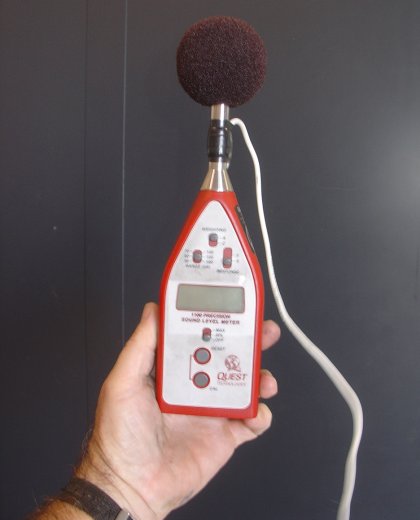Ask The MXperts: What Will Happen With the New 94dB AMA Sound Limits?
Dear MXA,
I read the AMA has lowered the sound limit from 99 decibels to 94 decibels for 2009. Given that the teams fought the drop down to 99, why are they willing to accept 94dB?

The American Motorcyclist Association (AMA) announced today that the 2009 Monster Energy AMA Supercross, an FIM World Championship, and the 2009 AMA Motocross Championship will adopt the FIM 94dBA sound standard.
The key words are adopt the FIM 94dBA sound standard.VbCrLf The FIM standard is easier to reach than the AMA standard because the rpm that the bikes are tested at is considerably lower (and the lower the rpm, the less the sound). The FIM will test 250 four-stroke at 5000 rpm and a 450 four-stroke at 4500 rpm. That is less rpm than the current AMA standards (which are typically 4800 rpm for a 450 and as between 5800 to 6000 rpm for 250Fs). By testing at a lower rpm level, the effect is that even the current 99dB AMA mufflers would probably test closer to 97dB on the European FIM scale. In addition, the FIM rounds down to the next lowest dB (thus a 100.9dB muffler is recorded on the FIM test as a 100dB muffler. That is a big break. Also, a team has to factor in the one decibel correction factor for Type 1 sound meters. That one dB correction factor is a freebie. All in all, with rounding off and the correction factor, a 95.9dB muffler would be considered a 94dB muffler by the FIM. Strange but true.ÿ
The rpm difference between the AMA and FIM is not a deal breaker though, because 94dB will still be a big step down in sound at the rpm where the bikes are tested. Sadly, the bikes will probably be only a little quieter when they hit the rpm ranges where they are actually used. In a recent test of mufflers, Pro Circuit built a 90dB muffler, 96dB muffler, 99db muffler and 102dB muffler. They tested all four mufflers with their sound test equipment and on their dyno. Once they had established all the criteria, they took all four mufflers out and did drive-by sound tests as full throttle. Surprise, all four mufflers were within 1dB of each other. They all ranged from 112dB to 113dB. Pro Circuit’s conclusion? Testing sound at a low rpm, when the bikes are ridden at a high rpm, is a total waste of time. And, the inherent problem with AMA/FIM sound testing is that it does not actually test anything even closely related to the real world. A 250F is tested at 5000 rpm, but revs to 13,500 rpm. A 450F is tested at 4500 rpm, but revs to 11,500 rpm. Why are the AMA and FIM wasting so much time testing something that only happens when the bikes are idling on the starting line?
By the way, using the AMA/FIM sound equipment, a bike running full blast on the dyno taps out at 132 decibels.
The plus of adopting the FIM standards is bureaucratic, in that the AMA bikes and FIM bikes will have to meet the same standard.
For those who like to mush around in the minutia of the rules, here are the FIM sound rules:

01.79 SOUND CONTROL
For the initial sound control and technical inspection, a rider (or his mechanic) shall present only one spare silencer per machine. Other spare silencers may be presented after all participants have presented their motorcycles, or on the following days of the event.
79.01
With the microphone placed at 50 cm from the exhaust pipe at an angle of 45-degrees, measured from the centre-line of the exhaust end and at the height of exhaust pipe, but at least 20 cm above the ground. If this is not possible, the measurement can be taken at 45-degrees upwards.
79.02
During the sound test only, every motorcycle must be equipped with an extension (min. 30 cm) to the spark plug cable, if requested by the Chief Technical Steward. One end of this extension must be plugged into the original spark plug cap whilst the other end has another spark plug cap and fitted normally on the spark plug.
During a sound test, machines not equipped with a gear box neutral must be placed on a stand. During the sound test, only the rider may take place on the machine in the normal riding position and operate the throttle. No other team personnel may influence the sound test.
79.03
The silencers will be marked when they are checked and it is not allowed to change them after the verification, except for any spare silencer which has also been checked and marked. All silencers will be checked and marked, once they have successfully passed the sound check. The end opening of the silencer shall remain unmodified once it has been checked and marked. Silencers fitted with adapters aimed to reduce the sound level shall be permanently fitted.
79.04
The rider shall keep his engine running and shall increase the engine speed until it reaches the specified Revolutions Per Minute (rpm). Measurements must be taken when the specified rpm is reached.
79.05
The rpm depends upon the mean piston speed corresponding to the stroke of the engine.
The rpm will be given by the relationship: N = 30,000 x cm divided by I.
ln which:
N = prescribed rpm of engine
cm= fixed mean piston speed in m/s
l = stroke in mm
79.08
A machine which does not comply with the sound limits can be presented several times at pre-race control.
79.12
The surrounding sound should not exceed 90dB/A within a 5 meters radius from the power source during tests.
79.13
Apparatus for sound control must be to international standard IEC 651, Type 1 or Type 2.
The sound level meter must be equipped with a calibrator for control and adjustment of the meter during periods of use.
79.14
The “slow response” setting must always be used.
79.15
Due to the influence of temperature on sound tests, all figures are correct at 20-degrees C. For tests taken at temperatures below 10-degrees C there will be a +1dB/A tolerance. For tests below 0-degrees C, a +2d/BA tolerance.
79.16
Sound control during and after the competition: In a competition which requires a final examination of machines before the results are announced, this examination must include a sound control measurement of at least three machines chosen at the discretion of the Clerk of the Course in co-operation with the Chief Technical Steward.
GUIDELINES FOR USE OF SOUND LEVEL METERS
80.01
The Sound Control Officer (NCO) must arrive in sufficient time for discussions with the Clerk of the Course and other Technical Officials in order that a suitable test site and testing policy can be agreed.
80.02
Sound level measuring equipment must include a compatible calibrator, which must be used immediately before testing begins and always just prior to a re-test if a disciplinary sanction may be imposed. Two sets of equipment must be available in case of failure of tachometer, sound level meter or calibrator during technical control.
80.03
Before testing, the NCO should if possible liaise with a maximum of two holders of FIM Entrant’s or Manufacturer’s licences, or team managers, who have sound test equipment including calibrators, in order to agree the accuracy of the official sound level meter.
80.04
Tests should not take place in rain or excessively damp conditions. Machines considered excessively noisy must be individually tested if conditions allow.
80.05
In other than moderate wind, machines should face forward in the wind direction. (Mechanical sound will blow forward, away from microphone).
80.06
‘Slow’ meter response must be used.
80.07
‘A’ weighted setting on sound level meter.
80.08
Always round down meter reading, that is: 100.9 dB/A= 100 dB/A.
80.09 Corrections
Type 1 meter: deduct 1 dB/A
Type 2 meter: deduct 2 dB/A
80.10 Temperature
Ambient temperature:
Below 10-degrees Celsius: deduct 1 dB/A
Below 00-degrees Celsius: deduct 2 dB/A.
All tolerances are accumulative. Action taken will depend on the sporting discipline concerned, and decisions taken during prior discussions with the Clerk of the Course.
79.06
The piston speed for Motocross (13m/s) is an equivalent approximate figure, for reference. For convenience, made possible by the similarity of engine stroke on current Motocross machines, within capacity classes, the test will be conducted at a fixed rpm :
Up to 85cc–8000 RPM
Over 85cc up to 125cc–7000 rpm
Over 125cc up to 150cc (four-stroke)–6,000 rpm
over 125 up to 250cc–5000 rpm
over 250cc up to 500cc–4500 rpm
over 500cc–4000 rpm
79.11
Sound limits in force: The maximum sound limit is set at :
Max. 96dB/A for motorcycles with a two-stroke engine.
Max. 94dB/A for motorcycles with a four-stroke engine.
79.16
Sound control during and after the competition:
In a competition which requires a final examination of machines before the results are announced, this examination must include a sound control measurement of at least three machines chosen at the discretion of the Clerk of the Course in co-operation with the Chief Technical Steward
HAVE A QUESTION?
email your questions to: mxa@hi-torque.com





Comments are closed.